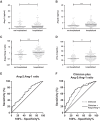The Angiopoietin-Tie-2 Axis in Children and Young Adults with Dengue Virus Infection in the Philippines
- PMID: 39137755
- PMCID: PMC11448529
- DOI: 10.4269/ajtmh.24-0115
The Angiopoietin-Tie-2 Axis in Children and Young Adults with Dengue Virus Infection in the Philippines
Abstract
Dengue virus (DENV) infection is associated with plasma leakage, which may progress to shock. The angiopoietin (Ang)-tyrosine kinase with immunoglobulin and epidermal growth factor homology domain 2 (Tie-2) axis regulates endothelial permeability. We examined the clinical utility of Ang-1, Ang-2, and the Ang-2-to-Ang-1 ratio for prediction of progression to severe DENV in a prospective cohort study of children and young adults (age 1 to <26 years) with DENV infection. Ang-1, Ang-2, Tie-2 were measured at presentation to an outpatient clinic in the Philippines from stored plasma by multiplex Luminex® assay. Patients were followed prospectively to document the clinical course (hospitalization, length of stay, intravenous fluid resuscitation, and transfer to a higher level facility). We included 244 patients (median age 9 years, 40% female). At presentation, 63 patients (26%) had uncomplicated dengue, 179 (73%) had dengue with warning signs, and 2 (0.82%) had severe dengue. One hundred eighty-one patients (74%) were hospitalized. Ang-1 levels were lower and Ang-2 higher in patients who required hospitalization. Ang-2-to-Ang-1 ratio >1 was associated with a relative risk of hospitalization of 1.20 (95% CI: 1.03-1.36, P = 0.016). A higher Ang-2-to-Ang-1 ratio was associated with longer length of hospital stay, higher frequency of transfer to a higher level facility, larger intravenous fluid requirement, hemoconcentration, and thrombocytopenia. Angiopoietin-2 was correlated with procalcitonin (Kendall's τ = 0.17, P = 0.00012), a marker of systemic inflammation, as well as soluble vascular cell adhesion molecule-1 (τ = 0.22, P <0.0001) and Endoglin (τ = 0.14, P = 0.0017), markers of endothelial activation. In conclusion, altered Ang-2-to-Ang-1 ratio can be detected early in the course of DENV infection and predicts clinically meaningful events (hospitalization, length of stay, and fluid resuscitation).
Figures




References
-
- World Health Organization , 2012. Dengue and Dengue Hemorrhagic Fever. Geneva, Switzerland: WHO.
MeSH terms
Substances
LinkOut - more resources
Full Text Sources
Medical
Miscellaneous

